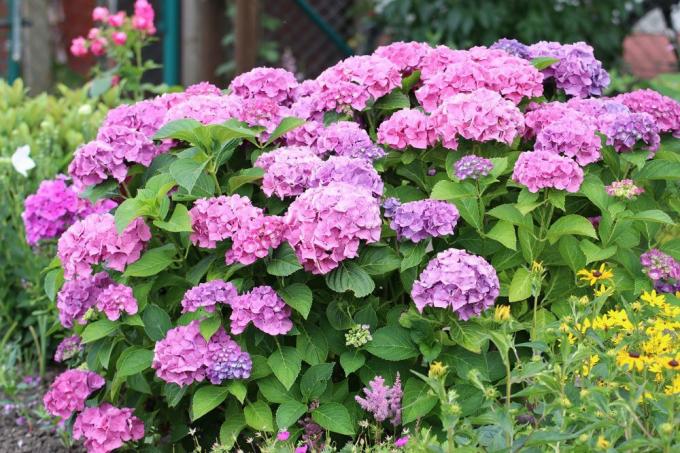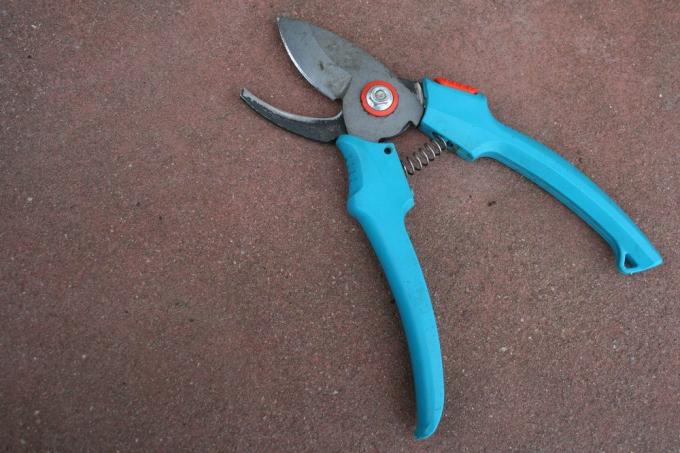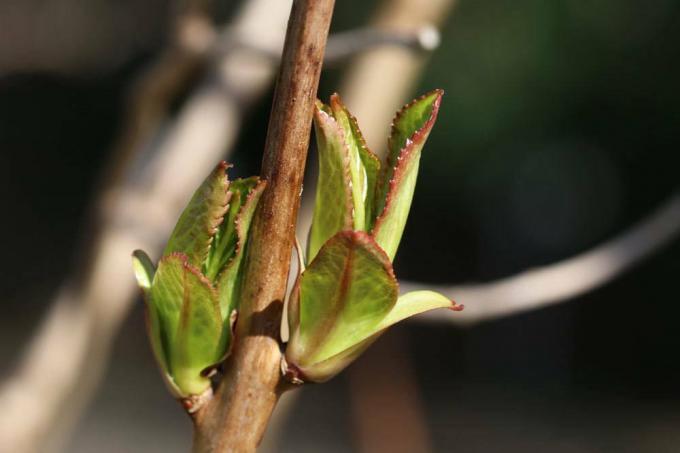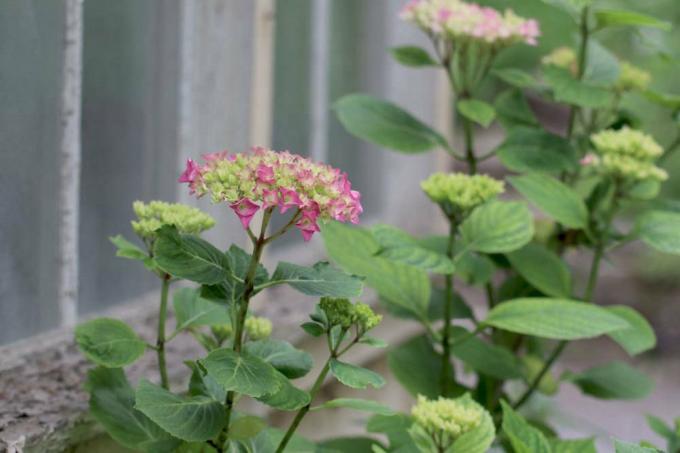
table of contents
- care
- Location
- Blue discoloration
- plants
- to water
- Fertilize
- Cut
- Multiply
- Diseases
Profile and care information open +conclude -
- Flower color
- pink, white, blue
- Location
- Partial shade, shady, sunny
- Heyday
- June, July, August, September
- Growth habit
- upright, spreading, bushy, perennial, subshrub, clump-forming
- height
- up to 200 centimeters high
- Soil type
- sandy, loamy, gritty
- Soil moisture
- moderately moist, fresh
- PH value
- weakly sour, sour
- Limescale tolerance
- Calcium tolerant
- humus
- rich in humus
- Poisonous
- Yes
- Plant families
- Hydrangea family, Hydrangeaceae
- Plant species
- Balcony plants, container plants, cut flowers, house plants
- Garden style
- Cottage garden, flower garden, terrace garden, pot garden
The farmer's hydrangea (Hydrangea macrophylla) is a plant that exudes a very special charm in the garden. Their umbrella-shaped inflorescences consist of many individual bluish, pink or white colored single flowers, the form on the subshrub from June and well into September for a wonderful spectacle in the garden care for. Unfortunately, the farmer's hydrangea is not sufficiently frost-resistant so that it can only be planted outdoors in mild locations.
care
Farm hydrangeas are very popular as summer bloomers. It's no wonder, because they don't need a lot of maintenance. What is important, however, is the correct location and soil. The garden hydrangea is easiest to care for in a partially shaded location. Still, planting is not enough. Since the garden hydrangea needs a lot of water, it must be watered regularly. And fertilizing must not be forgotten either.

Location
Garden hydrangeas can be planted in all regions with a temperate climate and not too harsh winters. The flowering subshrubs thrive particularly well when the humidity is slightly higher in a partially shaded location. In general, the Hydrangea macrophylla also tolerates sunny places, but then requires more maintenance as it has to be watered frequently.
- Light requirement: shady to partially shaded
- sheltered from the wind
- near house walls
The farmer's hydrangea is versatile. It not only beautifies cottage gardens, but also looks great as a solitary plant, in groups, on the balcony and terrace or as a houseplant. A year-round culture in a warm house is not recommended, however.
floor
With the right substrate, the best conditions for healthy and vigorous growth and abundant flowering are set right from the start. So it is important to pay a little attention to the garden soil or the plant substrate for the tub. The soil should be well permeable for water, because the flowering shrub does not tolerate waterlogging. On the other hand, it must also be able to store the water, as the garden hydrangea is sensitive to drought. Depending on the color of the flowers, a certain pH value must also be maintained in the substrate.
- well permeable
- humus
- Hydrangea substrate
- Rhododendron soil
- Mixture of garden soil or potting soil, peat and sand
- pH value for white and red colored varieties: around 5.5
- pH value for blue varieties: maximum 4.5

Blue discoloration
The flowers are blue in color
Some farm hydrangeas develop a beautiful blue color on the flowers. Over time, they may turn pink or pink. This is not due to a disease in the plant. A blue hydrangea has special soil requirements. Because the blue color only forms at a pH value between 4.0 and 4.5. If the soil is not acidic enough, the color no longer lasts and changes to a reddish tone. In addition, aluminum is necessary for the formation of the dye, which must be present in the soil in dissolved form.
- pH value: maximum 4.5
- Add acidic soil (such as rhododendron soil)
- acidic fertilizers: sulfuric acid ammonia
- additional aluminum fertilizer in spring
- alternatively give special fertilizer for blue hydrangeas
There are locations where acidic soil with low pH is already naturally present. If in doubt, this should be clarified with a soil sample or a test strip. If tap water is poured, the pH value can increase over time due to the lime it contains and the flower turns pink.
plants
The farmer's hydrangea may only be planted on the balcony or in the garden when frost is no longer to be expected. Specimens bought late in autumn should be wintered in a cool place in the house or garage to be on the safe side. Often the plants come straight from the greenhouse and first have to acclimate to the cold temperatures.
- Time: from mid-May
- by August at the latest
- Prepare the soil if necessary
- Mix heavy garden soil with sand or gravel
- Create a drainage layer
- Use only suitable substrates in the tub
- Plant spacing: half the stature height
Never plant a garden hydrangea too close to a large shrub or tree. If its roots are very dominant, they can, in the worst case, rob the garden hydrangea of water and nutrients, so that it only develops sparsely.
Bucket culture
We often cultivate garden hydrangeas in planters. Only use suitable substrates when planting. Well-drained soils with a very acidic pH value are ideal for hydrangeas. Otherwise, the same maintenance conditions apply to the plants as to outdoor plants. Low-growing varieties are best suited for planting in a tub. Keep in mind that over time the shrub will form quite a large root ball and older plants will therefore need a pot with a diameter of 40 to 60 cm.
- Use a planter with drainage holes
- Fill in the drainage layer (chippings, expanded clay, lava granulate)
- use only suitable substrates

to water
The generic name Hydrangea means water shrub and refers to the fact that the shrub likes to grow on moist soil. That is why the garden hydrangea must always be adequately watered. At least until it has grown well after about a year. After that, additional watering is only necessary for plants that are planted in the bed if it has not rained for several days. Frequent checks are still necessary for potted plants. The farmer's hydrangea is very sensitive to a lack of water. If it is too dry for her, she quickly lets her leaves hang down. If you wait too long before watering, the flowers wither or the buds won't open.
- always keep slightly moist
- must never dry out completely
- does not tolerate waterlogging
- preferably water with low-lime water
In sunny locations or in persistent heat and drought, daily watering may be necessary, especially with container plants. Always keep the substrate slightly moist. The soil may dry out between watering, but not completely dry out.
Fertilize
Only when the subshrub finds sufficient amounts of nutrients can a lush bloom develop. Therefore it is necessary to fertilize in the growing season. The garden hydrangea needs a fertilizer that contains high amounts of nitrogen but little phosphorus. It is best to use a special hydrangea fertilizer. Universal fertilizers are not suitable for farm hydrangeas.
- first fertilization in May
- a second in early summer
- It is best to use solid slow-release fertilizers for bedding plants
- Fertilize potted plants with liquid fertilizer over the irrigation water
- Hydrangea fertilizer
- alternatively: Rhododendrons- or azalea fertilizer
- a special fertilizer is required for blue varieties
Repot
The best time to repot potted plants is early spring, before the farm hydrangea sprouts again. In this way you create ideal starting conditions for the coming growing season. If the pot becomes too small at another point in the year, it can in principle be repotted all year round.
- Carefully pull the plant out of the pot
- Slightly loosen the root network
- in older shrubs, cut about 1 cm of the root tips
- Create a drainage layer
- use only suitable substrates
- water lightly

If you repot during the flowering phase, the roots should not be damaged. In this case, simply take the shrub out of the old pot, put it in a somewhat larger planter and fill it all around with soil. This way you don't disturb the garden hydrangea when it opens its flowers.
Cut
It is easy to make mistakes when cutting the garden hydrangea. In general, hydrangeas are divided into two cutting groups. The farm hydrangeas belong to the first group. In the spring, these shrubs are only allowed to be pruned weakly. Only frozen shoots and the old flowers are removed. The flowering shrub sets the buds for the coming spring in autumn of the previous year, when the temperatures fall below 20 degrees again. If you cut off too much, the flower will not bloom.
- Time: before budding in spring (end of February)
- just remove old flowers
- Cut just above the first bud
- Exception: the 'Endless Summer' variety
- it forms flowers on this year's wood
- can be cut as desired in spring
Some garden hydrangeas already bloom in June and bloom tirelessly until late September. The flowers do not have to be removed before winter, because covered with frost or snow they give the garden a very special charm.

Conservation cut
In addition to the careful spring pruning of the flowers, there is another pruning measure for the farm hydrangea. This primarily serves to keep the shrub healthy. In principle, a maintenance cut can be carried out all year round. The best time, however, is the spring after the new shoots have emerged. At this point in time, even the layman can easily see which shoots did not survive the winter.
- Time: in the spring after new growth
- Remove all dead / frozen branches
- cut diseased shoots
- cut off the weaker of two intersecting shoots
- cut all inward-growing branches at the base
Toxicity
All parts of the farm hydrangea are poisonous. The toxins include hydrocyanic acid, which destroys the red blood cells. Since the oxygen transport can come to a standstill, there is a risk of death from heart failure in the worst case. There are also toxins such as saponins in the leaves and buds. When ingesting larger amounts, these substances cause dizziness or anxiety. However, since the concentration of toxins is very low and the plant also tastes very bitter, the Hydrangea macrophylla is considered relatively harmless to humans. However, it is poisonous to dogs, cats, rabbits and rodents.
Overwinter
In the meantime there are always new breeds that differ not only in the color of the flowers and the shape of the leaves, but above all in their winter hardiness. If the farmer's hydrangea is to be planted outdoors, varieties with a higher frost tolerance are recommended.
Outdoor plants
The Hydrangea macrophylla is only partially hardy. For the gardener, this means that in harsh winters the shoots with the sensitive bud systems can die off. Therefore, it makes sense to cover not only the roots, but also the shoots. It is best to use permeable material such as gauze or jute so that the air can circulate well and mold and disease do not develop. Protection from the blazing winter sun is even more important than insulating the hydrangea shoots from the cold.
- Cover the ground with straw, dry leaves or sticks
- also protect the shoots in cold winters
- Wrap loosely air-permeable fleece
- Wrap the trunk of tall trees with jute or fleece

Potted plants
When keeping the farmer's hydrangea as a container plant, a few additional factors must be taken into account. For example, the root ball must be protected from freezing through.
- Place the bucket in a sheltered, partially shaded place
- preferably on an east or south-east wall
- safe from icy winds
- Roots must not freeze through
- Place the pot on a thick styrofoam plate
- Wrap a double layer of bubble wrap or other insulating material
- Cover the substrate surface with leaves or straw
- Wrap shoots with air-permeable material
- Jute or gauze fleeces are suitable
Alternatively, a potted hydrangea can be placed in a cool but frost-free room. This may be necessary for all potted plants if the outside temperatures drop sharply into the minus range over the long term. Since the garden hydrangea sheds its leaves in autumn, it does not need any light. The winter quarters can be a garage or a frost-free shed, for example. Even unheated, cool cellars with temperatures below 10 degrees are suitable for winter storage. With frost-free overwintering, it must be checked regularly whether the plants need water.

Multiply
Basically, the farmer's hydrangea can be propagated from seeds as well as from cuttings. The usual method is to grow from cuttings as it guarantees identical offspring.
Cuttings
For propagation from cuttings, it is best to use largely unwooded, annual shoots without a flower base.
- Time: June or July
- Cut 15 cm long shoots
- remove lower leaves
- Cut remaining leaves to half size
- Cut the shoot tip
- stick in moist cactus or seed soil
- place in a shady place
After about two to three weeks, roots will form on the cutting. From September the young plants are repotted in their own plant pot with a diameter of 10 to 12 cm in hydrangea substrate. In the following spring (May) the bushes are big enough to be taken outside.

Diseases
In many cases, when the leaves develop brown or the flowers wither, the plant will run out of nutrients. Often times, these problems go away quickly when you fertilize the farmer's hydrangea. The deficiency symptoms also include chlorosis, which can be recognized by yellow-green leaf veins or leaves. The reason for this is an iron deficit or an excessively high pH value in the soil.
Pests
Aphids, Thrips and spider mites don't stop at a weakened hydrangea either. In the case of light infestation, agents that are gentle on beneficial organisms can be used. At the same time, it is important to strengthen the plant. A nitrogenous fertilizer strengthens the shrub. Also, make sure that the soil doesn't dry out excessively.
